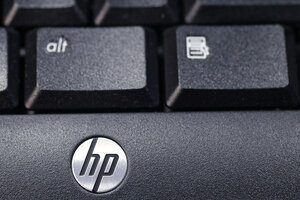Hewlett-Packard breakup means the death of the hardware superstore
Hewlett-Packard will split into two companies, worth about $55 billion apiece. The breakup is meant to give the two HP companies the agility to better respond to market demands, but there could be trouble ahead.

The company logo on a Hewlett-Packard keyboard at the Micro Center computer store in Santa Clara, Calif. Hewlett-Packard on Monday, Oct. 6, 2014 said it is splitting itself into two companies, one focused on its personal computer and printing business and another on technology services, such as data storage, servers and software, as it aims to drive profits higher.
Paul Sakuma/AP/File
Hewlett-Packard is breaking up.
It will split in half. One half will be PCs and printers, a business with just more than $55 billion in revenue. The other half will be servers, networking, storage, software, services and other enterprise offerings, also just over $55 billion. The inescapable conclusion? It didn't work.
HP has been structured as a scale play on the PC ecosystem ever since ex-CEO Carly Fiorina shed Agilent and bought Compaq 15 years ago. During his tenure there, former HP CEO Mark Hurd described it to me as an enterprise share-of-wallet play, leveraging the size of the consumer market along the way.
It's like big-box retail, the idea went: The bigger you are, the more you can pressure suppliers for cheap prices. And once you have a customer in the door, you can sell a bit of everything. HP was supposed to be the irresistible hardware superstore.
The problem with mere scale
The difficulty is that when you try to be all things to all people, which a scale play must necessarily do, it can prevent you from hitting key trends and executing the special thing really well (as we've seen in fashion, healthy food or customer service).
So when something major changes—like mobile (ARM, iOS, Android) rocks the PC ecosystem and cloud (IaaS, SaaS) rocks the enterprise channel, scale plays based on a previous era can be caught flat-footed.
This breakup doesn't necessarily correct that.
Here's the problem with a broken-up HP: The company's Printing and Personal Systems Group is uniquely good at printing, and that's about it. The group is a player in a bunch of interesting, mostly commodity businesses, but nothing that's growing particularly fast.
The enterprise group has a lot of also-ran businesses, including servers, storage, networking and software. There are some decent assets in storage, but nothing that you'd think will provide the kind of long-term advantage that's going to inspire faith.
Storms ahead
On the consumer side, there's the threat of a continuing secular collapse. If PC business growth doesn't continue (because, in a situation I view as likely, consumers are going to continue waiting far longer than the traditional three years to replace the PCs they're buying now), and people instead adopt targeted hardware that works better, that hurts both ends of the consumer business.
On the enterprise side, Hewlett Packard Enterprise (the other half of the split) has a server business that will be threatened by contract manufacturers and by Lenovo, once it gets rolling with its server business newly acquired from IBM.
In its other businesses, Hewlett-Packard Enterprise will have neither obvious intellectual property advantages nor scale: Networking is Cisco's game.
Storage is getting slammed by cloud trends, and it's not clear that a risky combination with EMC (which would have to spin off VMware to manage it) would help much. The software business is stagnant despite the Hail Mary acquisition of Autonomy years ago. And the services business continues to be stuck in the mud.
The breakup could end up being a good thing, but it doesn't fix much. Instead of one huge troubled business, we'll have two big troubled businesses.

